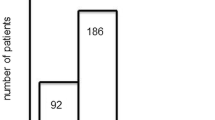Abstract
Included in this study were 43 cases of mucocutaneous lymph node syndrome (MCLS or Kawasaki disease) treated solely with aspirin. Of these, 19 developed coronary aneurysm. Mononuclear cells (MNC) of these MCLS patients were collected weekly and stimulated either with phytohaemagglutinin (PHA) or PHA plus phorbol myristic acetate. The production of interleukin-2 (IL-2), tumour necrotic factor (TNF) and gamma-interferon (IFN-r) was determined. In addition, IL-2, TNF, IFN-r from serial collections of serum samples of these patients were also measured. The results show that serum IL-2 and TNF were detected in the 1st week, reached maximal plateau in the 2nd and 3rd week and decreased 1 month later. The production of IL-2, TNF and IFN-r from MCLS patients' MNC increased from the 1st to the 3rd week, persisted at a high level for 1 month and then decreased. During the 2nd and 3rd weeks, there were significantly higher serum IL-2 levels and IL-2 production in patients with than in patients without coronary lesions. These observations suggest that the serum IL-2 level and IL-2 production during the 2nd week may serve as a predictive parameter for coronary aneurysm formation. It also suggests that the production of TNF, IL-2 and IFN-r from MNC may contribute to the development of vascular injury in acute MCLS.
Similar content being viewed by others
Abbreviations
- IFN-r:
-
gamma-interferon
- IL-1:
-
interleukin-1
- IL-2:
-
interleukin-2
- MCLS:
-
mucocutaneous lymph node syndrom
- MNC:
-
mononuclear cells
- PHA:
-
phytohaemagglutinin
- PMA:
-
phorbol myristic acetate
- TNF:
-
tumour necrotic factor
References
Beuther B, Cerami A (1986) Cachectin and tumor necrotic factor as two sides of the same biological coin. Nature 320:584–588
Fujiwara H, Hamashima Y (1978) Pathology of the heart in kawasaki disease. Pediatrics 61:100–107
Japan Kawasaki Disease Research Committee (1984) Diagnostic guideline of Kawasaki disease, rev edn 4. Tokyo, Japan, Kawasaki Disease Research Committee
Kato H, Inoue O, Akagi T (1988) Kawasaki disease: cardiac problems and management. Pediatrics 9:209–217
Kawasaki T (1969) Mucocutaneous lymph node syndromeclinical observation of 50 cases. Jpn J Allergol 16:178–222
Leung DYM, Siegel L, Grady S, Krensky A, Meade R, Reinherz EL, Geha RS (1982) Immunoregulatory abnormalities in mucocutaneous lymph node syndrome. Clin Immunol Immunopathol 23:100–112
Leung DYM, Chu ET, Wood N, Grady S, Meade R, Geha RS (1983) Immunoregulatory T cell abnormalities in mucocutaneous lymph node syndrome. J Immunol 130:2002–2004
Leung DYM, Geha RS, Newburger JW, Burns JC, Fiers W, Lapierre LA, Pober JS (1986) Two monkines, interleukin-1 and tumor necrosis factor, render cultured vascular endothelial cells susceptible to lysis by antibodies circulating during kawasaki syndrome. J Exp Med 164:1958–1972
Lin CY, Hwang B (1987) Serial immunologic studies in patients with mucocutaneous lymph node syndrome (Kawasaki disease). Ann Allergy 59:291–297
Lin CY, Low TLK (1989) A comparative study on the immunological effects of bovine and porcine thymic extracts: induction of lymphoproliferative response and enhancement of interleukin-2, gamma-interferon and tumor necrotic factor production in vitro on cord blood lymphocytes. Immunopharmacology (in press)
Lin CY, Hwang B, Chiang BN (1986) High risk factors in the development of coronary aneurysms in patients with mucocutaneous lymph node syndrome (Kawasaki disease). Acta Cardiologica Sinica 2:253–262
Lin CY, Kuo YC, Lin CC, Ou BR (1988) Enhancement of interleukin-2 and r-interferon production in vitro on cord blood lymphocytes and in vivo on primary cellular immunodeficiency patients with thymic extract (Thymostimulin). J Clin Immunol 8:103–107
Lin CY, Lin MT, Hsieh YL, Tsao LY (1988) Transient disappearance of immunologic disorders and remission after intercurrent measles infections in children with chronic idiopathic thrombocytopenic purpura. J Clin Immunol 8:207–213
Robb RJ (1984) Interleukin 2: the molecule and its function. Immunol Today 5:203–206
The Third International Kawasaki Disease Symposium (1988) Tokyo, Japan, 29 Nov-2 Dec. Japan Heart Fundation, Tokyo, pp 21–26
Yanagawa H, Kawaski T, Shigematsu I (1987) Nationwide survey on kawaski disease in Japan. Pediatrics 80:58–62
Author information
Authors and Affiliations
Rights and permissions
About this article
Cite this article
Lin, C.Y., Lin, C.C., Hwang, B. et al. The changes of interleukin-2, tumour necrotic factor and gamma-interferon production among patients with Kawasaki disease. Eur J Pediatr 150, 179–182 (1991). https://doi.org/10.1007/BF01963561
Received:
Accepted:
Issue Date:
DOI: https://doi.org/10.1007/BF01963561



